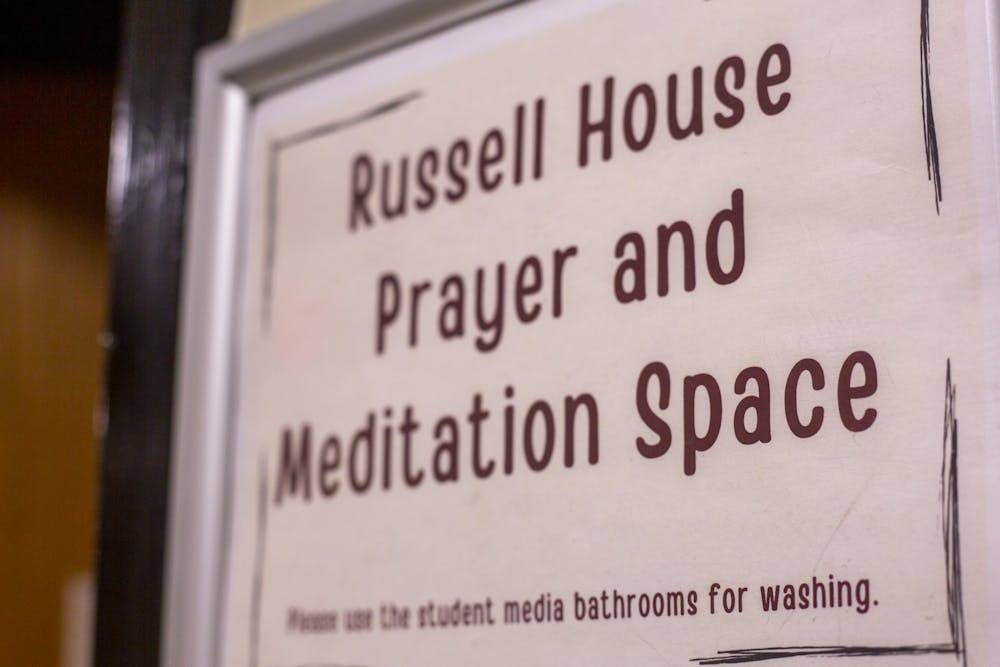A permanent place for religious prayer and meditation is now located in room 309 of Russell House.
In the new prayer-friendly space, there are two different entrances to separate female and male-identifying students with a black curtain. As students walk in, they see tape indicating which direction to pray in and where to leave their shoes.
The space is open as long as Russell House is open, which is 7 a.m. to 11 p.m. The space was created by The Office of Multicultural Student Affairs (OMSA) with the idea originating from the Muslim Student Association (MSA).
Farboud Khatami, a Ph.D. civil engineering student and the interfaith coordinator for the MSA, said these spaces don’t claim a certain religion or practice. Even if a student doesn’t resonate with religion, it's a calm place to breathe during a stressful school day.
With a bathroom nearby, Muslim students have access to water to perform Wudu — a ritual of cleansing before prayer. People can wash their hands, put water on their feet and place their shoes down before they walk into the prayer space.
The MSA made sure inclusion was at the forefront of this new space. This meant longer hours for Muslims to complete their five prayers every day.
Farehaa “Fay” Hussain, a fourth-year pharmacy student and the director of public relations for the MSA, said every decision was made to accommodate all students from different religious and cultural backgrounds.
During Hussain’s freshman year, an Islamic holiday occurred during one of her first days on campus. There wasn’t any recognition of the holiday and feeling so far from her faith, she cried and wished she had a space like the one in the Russell House now.
She said students complained about how prayer and meditation spaces on campus were being used as study rooms for others to do homework.
“As a Muslim, prayer especially is something that five times a day, not only is it a religious obligation, but for me, it’s something I need to do for my own peace of mind — for my mental health,” Hussain said.
Hussain and Khatami said they worked after classes for hours coming up with ideas for the room. In the end, they curated a 10-page document to show Shay Malone, director of multicultural student affairs, what other schools’ meditation spaces looked like.
Malone emphasized the importance of cultural inclusion on campus.
“It’s part of their daily lives as students. It’s important for us to make that we recognize that they need those spaces to pray during the day because that’s who they are,” Malone said.
Hussain said what was especially important to her was making sure there were security cameras nearby to keep students safe from people with “bias in their heart." She said the need for security became evident after the interfaith space at Arizona State University was vandalized on Dec. 9, 2021.
There are five other prayer spaces on and off campus including room B104 in 300 Main Street Prayer Space, the Carolina Faith Center, room 215 in the Center for Health and Wellbeing, Room 470 in the Close-Hipp Building and Room 116 in Hamilton College. However, these spaces have limited hours in the 7:30 a.m. and 6:45 p.m. range.
Hussain said Close-Hipp’s prayer space was less than satisfactory. It is a tight space with room for one person to fit in.
“It was literally the size of a closet,” Hussain said. “I wish I could say it was even the size of a nice closet, but it really wasn’t.”
When people pass by the space she helped create, she compared her heart to the Grinch’s and joked, saying it “swells up three sizes." They show interest in its purpose and more awareness makes her proud of what the MSA has done.
“It sounds cheesy, but whenever I go past one of these rooms and I see someone praying in there, there's a nice feeling,” Khatami said. “You’ve done something that ... really enhances the student experience.”

